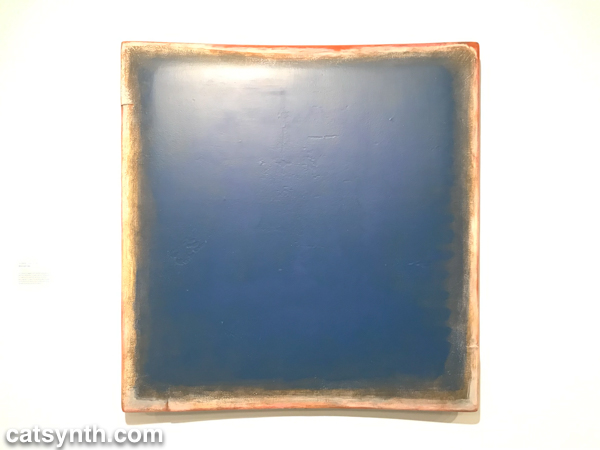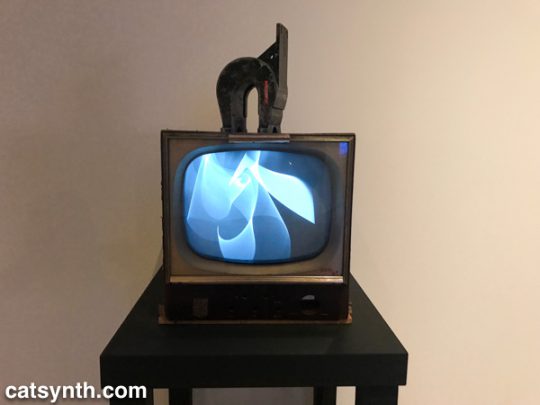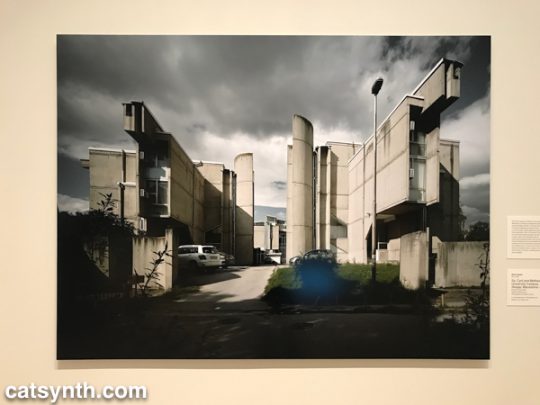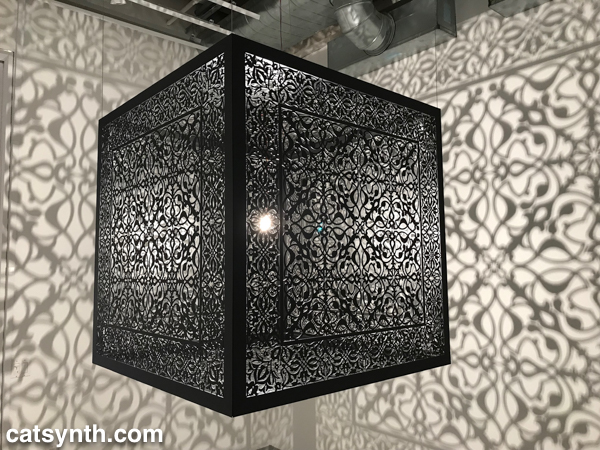
Classic Mark di Suvero sculpture in a lot along 11th Avenue in the Chelsea neighborhood of New York.

The end-of-year colage has become a long-standing tradition here at CatSynth, and one that I particularly enjoy. It was a complex year, and the images reflect that. Our cats Sam Sam and “Big Merp” (who has pretty much become an indoor-outdoor cat at his new home in Oakland), some great shows including outstanding performances with CDP and Vacuum Tree Head, a wonderful and restorative visit back to New York. It was also dark and fiery at times, as when the Camp Fire leveled the town of Paradise and bathed our sky in smoke and ash – beautiful and tragic all at once.
Another New Year tradition at CatSynth is to share some stats from the past year. First, the basics:
Our top posts for the year, using the somewhat shaky measurements of Google Analytics:
It was heartening to see such a diverse set of posts top the list. However, this belies the fact that blog readership is way down, and eclipsed by Facebook and YouTube / CatSynth TV. Most of our referrals to the blog come from these two sources; but most activity stays on Facebook and YouTube. On the plus side, CatSynth TV viewership has grown significantly. Here are the top videos for the year.
Clearly, the NAMM reviews and synth demos dominate the channel, though I am proud of the diversity of art, music, and culture topics shared there as well. Overall, we at CatSynth do see the writing on the wall, and the efforts in 2019 will probably accelerate the shift from blog to video in terms of time, energy and investment.
On a more personal and introspective note, 2018 was a year we accomplished a lot. At the same time, it ends feeling like I both did too much and didn’t do enough. There are still so many things going on, even as we tried to consolidate and focus. One of the challenges going into 2019 will be looking at how to stay organized and even more focused, without giving up on all that we do. Also, like birthdays, a new year is a reminder that time is passing, and we are getting a bit older. Taking care of myself will also be a priority.
Thank you all as always for sharing this past year with us, and wish wish everyone a Happy New Year!
After seeing Kwang Young Chun’s Aggregations at Sundaram Tagore Gallery (read our review of that show), I knew I needed to check out his solo exhibition at the Brooklyn Museum. I expected more of the same style of abstract triangulated paper constructions, but on a larger scale. And I was not disappointed.

These large other-worldly constructions are formed from small tightly folded prisms of mulberry paper. This thin and delicate paper is prized as an artistic material but also has mundane uses as wrappers. Chun primarily sources his paper from old books.

The freestanding central piece, which I believe was Aggregation 15-JL038 (his titles all rather cryptic alphanumeric combinations), was particularly intense and seemed like a cratered surface of a large asteroid. The remaining pieces were wall-mounted, but still combined light and shadow, roughness and smoothness, in a similar way.

There is something I find deeply captivating about Chun’s sculptures. They seem like something I might have generated on the computer, but they are made of paper. They seem solid and heavy, but fragile at the same time. I also liked the juxtaposition of blue with the otherwise grayscale elements. I found myself sitting in the middle of the gallery and contemplating each of them for a long time, longer than I usually sit with individual pieces on a whirlwind trip through a museum.

Blue seemed to be the color of the day. Even before reaching Kwang Young Chun’s exhibition, I was greeted by Infinite Blue, a survey of art and design objects from the museum’s collection.

I have long been drawn to blue – along with purple, it is a color I welcome into my own art and design, and one of the few colors that I wear. It’s also historically a rarer color and one that is not often found in nature (other than the blue tint of the sky and water). The exhibition goes through different places and periods of art and craft incorporating blue, often juxtaposing traditional objects with contemporary art. For example, the Chinese porcelain in the image above was paired with contemporary paintings by Chinese artist Su Xiaobai.

I tend to be most drawn to objects that are more abstract and geometric. As such, the section featuring 19th-century American decorative arts did nothing for me. By contrast, I enjoyed seeing a Korean 19th-century porcelain bottle with 20th-century American designs in blue glass.


I do, however, have a soft spot for fish.

The most powerful element tying the entire exhibition together was the opening piece, one of Joseph Kosuth’s neon text works 276 (On Color Blue).

And this is perhaps a fitting way to close this article. There was more to see and share from this visit to the Brooklyn Museum, but we shall save that for a subsequent article.
On this dreary, rainy afternoon, we turn our attention southeast to the small town of Belen, New Mexico.





 Belen is near the geographical center of New Mexico, south of Albuquerque. It is wedged between Interstate 25 to the west and the Rio Grande to the east. Business Loop 25 serves as the town’s Main Street, as well as the terminus for New Mexico state roads 314, 309, and 109. In its past, it served as a major railroad hub, even earning the nickname “Hub City.”
Belen is near the geographical center of New Mexico, south of Albuquerque. It is wedged between Interstate 25 to the west and the Rio Grande to the east. Business Loop 25 serves as the town’s Main Street, as well as the terminus for New Mexico state roads 314, 309, and 109. In its past, it served as a major railroad hub, even earning the nickname “Hub City.”
New Mexico is a place steeped in a unique character, bringing together Native American, Spanish, and Northern European heritage. Its landscape is bleak and beautiful. It has attracted generations of artists. Judy Chicago is one of those artists, and she chose to make her home in Belen.
Chicago is one of the founders of feminist art, a collection of art movements that serve to both create and critique art from the perspective of women. Early work by Chicago and others in this movement often turned assumptions upside down, sometimes slyly but sometimes not so subtly inserting womanhood into all types of artistic practice. But she has also been involved in work beyond feminism, notably The Holocaust Project.
Perhaps her best-known piece is The Dinner Party, which is now a permanent installation at the Brooklyn Museum in New York. I have had the opportunity to view it on multiple occasions.

The Dinner Party imagines women artists, thinkers, and leaders throughout history sitting at a large triangular table. Each of the place settings bears the name of an accomplished woman and the contents of her plate represent a stylized version of her accomplished. Additionally, the porcelain tiles surrounding the table identify nearly 1000 other women. The plates and their contents are often described as representing female sexuality through vulva-like, floral, and butterfly forms.
Returning from Brooklyn to Belen, we pick up the story in this weekend’s New York Times, about an effort by the town to host a museum dedicate to its famous resident and the art she creates and supports. This would seem to be a slam dunk for a town that appears to have fallen on hard times, but it apparently generated quite a bit of opposition.
The quarreling reflects not just the power of Ms. Chicago’s art to ignite emotions, but also the limits of tolerance in New Mexico, a state long known as a welcoming mecca for artists. Evangelical Christian leaders in Belen have mobilized to thwart the project, calling Ms. Chicago’s art pornographic and indecent.
[link]
“I love fine art, but I would never want to see a vagina hanging on my wall,” said John K. Thompson, 62, a retired stockbroker.
It seems odd that the state that celebrates Georgia O’Keefe would have a problem with vaginal imagery in art. So why this place, and why now?
Paula Castillo [a sculptor who was born and raised in Belen] believes that the friction reflects the town’s own evolving dynamics…Belen has long been home to Hispanic families whose roots in New Mexico go back centuries. Religious affiliations are in flux, but many remain members of the Roman Catholic Church, which has not voiced opposition to the museum.
But after meeting with pastors from the evangelical churches opposing the museum, Ms. Castillo said she concluded that much of the resistance appeared to come from relative newcomers who brought more conservative sensibilities with them.
“There’s a level of nuance to what’s going on that’s been neglected,” Ms. Castillo said. “Belen and the rest of New Mexico can be very welcoming, but it’s easy to forget the influence that some churches now have.”
Indeed, I had come to think that despite the power of conservative Christians in our politics, the somewhat cartoonish cries of “indecency” in art were a sad joke from my past. Not surprising, this has been an upsetting experience for Chicago herself. I can only imagine what it feels like to feel welcomed in a community, only to have part of that community turn against you…
Responding to the critics, Ms. Chicago and Mr. Woodman in November withdrew their offer to work with Belen’s municipal government on the proposed museum. “The whole experience has been very painful,” said Ms. Chicago, explaining how she followed the debate over the museum and her work on social media while she was traveling in Brazil
It seems like a potential opportunity missed, especially as one sees how embracing minimalist Donald Judd put Marfa, Texas, on the map and has made it a cultural destination. Indeed, Marfa is on my bucket list, especially after seeing it featured in one of the last episodes of Anthony Bourdain’s show. Whether Belen gives up its chance to be another Marfa remains to be seen.
See more of New Mexico and many other fascinating places in our Highway☆ app, available on the Apple App Store and Google Play Store.


We at CatSynth have long been interested in the intersection of art, technology and conceptual process. Programmed: Rules, Codes, and Choreographies in Art, 1965–2018 surveys over 50 years of video, computational and conceptual art, cleverly weaving them together into a single narrative whole. The three disciplines are united by the concept of a “program” or set of instructions through which the work of art unfolds, whether a computer program, instructions for a performance, or strict concept on a visual object. Video and lights abound, but there is also painting, dance, and more.

One of the artists who
At the opposite end of the video spectrum is his 1965 piece Magnet TV. A black-and-white CRT television set is disrupted by a large magnet, creating a unique but sometimes unpredictable pattern that is in its way rather spare and graceful.

In the first piece, the process is in the composition, arrangement, and looping of the various video clips. In the latter, it is the physics of the magnet and the CRT.
Motion and experiments with electronics are also at the heart of James L. Seawright’s contemporaneous piece, Searcher, which features gradual motion and changes in light. The shadows it casts are also part of the experience of the piece.

There is an interesting juxtaposition of one Joseph Kosuth’s classic neon text pieces, Five Words in Green Neon, and W. Bradford Paley’s Code Profiles, a Java program that generates images. They bring together the concepts of “text as art” and “code as art” – the message is the medium.


Paley’s code may be one of the most literal examples of the exhibition’s theme, but code need not be computer code as we think of it today. Many works from earlier periods were based on a series of instructions, where the instructions are the work and the performance or visual object are the expressions of said work. One such example is Sol Le Witt’s sculpture Five Towers. The three-dimension grids are assembled by a program with various combinations into a simple but beautiful result. I particularly enjoyed looking through it.

Josef Albers’ color-field rectangles can similarly be generated from a “program”. Like Le Witt’s piece, one could conceive of doing something like this with a computer, but neither artist chose to do so, instead being themselves the interpreters for the code.

The performing arts have long been linked to programs, whether the traditional score or choreography, or more modern uses of algorithms or conceptual instructions.

Program, object, video and performance also come together Lynn Hershman Leeson’s Lorna. Lorna is an interactive video story on a laser disc (anyone else remember laser discs?). Users can determine how the story unfolds through one of three endings via a remote control. The screen and control are placed within a simulated apartment decked out entirely in leopard print, and the viewer is invited to sit in a comfy chair while the controlling the story. This self-guided performance is at once programmed, but also immersive in that the viewer becomes part of the piece, both in space and in terms of control.

Video permeates the entire exhibition, popping up directly and indirectly in at least half of the pieces, or not more. But

We conclude this survey with a new site-specific commission by Tamiko Thiel. She created an augmented-reality mobile app (in collaboration with developer /p) that overlays organic forms on the angular, geometric space of the museum’s outdoor terrace.
Thiel’s organic growths are beautiful and playful, but also have a darker aspect. Some resemble plastic refuse, and others coral formations. Both are emblematic of the crises facing our seas due to pollution and climate change. At the same time, the algorithmic process she uses, a formal grammar developed in 1968 by the Hungarian biologist and botanist Aristid Lindenmayer, is fascinating.

There were many more works in this exhibition that we can discuss in a single article. Each one had something compelling and different about it. For anyone interested in or curious about these forms of art, I highly recommend checking out this exhibit!
Programmed: Rules, Codes, and Choreographies in Art, 1965–2018 will be on display at the Whitney Museum of American Art through April 14, 2019.
We at CatSynth are admirers of brutalism, as anyone who follows us on Twitter can attest. We love the geometric forms, how it screams “modern”, and how it makes such an intense break with tradition. And I will admit, I also have a little fun using it to poke fun at the architectural conservatism prevalent in places like San Francisco. But above all, it provides a singular beauty to built spaces.
Brutalism perhaps reached its zenith in the former Yugoslavia during the period between the end of World War II and 1980, a period that is highlighted in a current exhibition at the MoMA, Toward a Concrete Utopia: Architecture in Yugoslavia, 1948–1980. It highlights the work of several Yugoslavian architects in the period and pieces ranging from prosaic apartments to public arenas to monuments. The buildings themselves are, of course, not on display in the museum, but their stories are told through models, photographs, and examples of interior objects.

A convergence of factors came together which allowed these modernist experiments to flourish. Yugoslavia broke away from the Soviet bloc in 1948 and began to forge its own socialist path and identity. It constituted itself as six republics in a federation in which traditional regional identities were subordinate to a new and modern whole. At the same time, the country was devastated by World War II and needed massive rebuilding. Finally, new ideas in architecture were emerging along with new materials, notably advances in concrete, steel, and glass allowed a new built environment to take shape.

The simple forms and surfaces were used for everyday buildings, such as apartment complexes, schools, and medical facilities. But rather than just one-offs, they become part of a unified cityscape, a grand plan. This was perhaps no more so than in Skopje, the capital of Macedonia, which was devasted by an earthquake in 1963 and largely rebuild using modernist design and principals.


There are, of course, numerous rectilinear designs, sometimes in steel and glass, and sometimes dominated by concrete. But concrete also allowed for the exploration of curved structures and organic shapes. We see this in many of the large civic arenas, but also in the brutalist monuments built in the post-war period. This “cell-like” structure in Macedonia takes it to the extreme, looking at once like an organic organism and a spaceship.

Wandering through the exhibition, one cannot help but imagine being the real spaces. For me, the modernist, severe style brings a sense of calm and welcome that more traditional styles don’t always provide.

Sadly, the Yugoslavian experiment ultimately failed, with country breaking apart and the entire region plunging into extreme nationalism and devastating wars in the 1990s. This is a cautionary tale as we watch the plague of nationalism rising around the world, including in the United States. Many of the architectural works in this exhibition did survive the wars. But they do face continued challenges to their survival, including maintenance and a push to return to more “traditional” forms. The “Skopje 2014” initiative, for example, is both farcical and tragic. Despite these challenges, I hope the countries of the region will recognize and preserve the legacy of their modernist period for years to come.
This article only scratches the rough, hardened surface of the wealth in this exhibition. It was truly a wonderful experience, even if so much was in my imagination through the artifacts. Toward a Concrete Utopia: Architecture in Yugoslavia, 1948–1980 will be on display at the Museum of Modern Art in New York through January 13, 2019.
The Art of Paper is a multi-artist exhibition currently on display Sundaram Tagore Gallery at their Chelsea location. The term “works on paper” often refers to drawing and print, but the medium and can be used in so many more ways. Each of the artists in the show uses paper in a very different way, showcasing its breadth and versatility as a raw material for art.
Korean artist Chun Kwang Young creates fantastic three-dimensional sculptures from mulberry paper. This thin and delicate paper is prized as an artistic

Some are flat and wall-mounted while others are freestanding. But in all cases, they are three-dimensional full of complex depth and texture.
The jagged triangular elements seem sharp, even a bit dangerous up close. But at the same time, they seem fragile, like delicate crystals that could fall apart among touch. When viewing closer, they seem soft, especially as the details of the paper come into view, including the original printed text from the source material. There is something almost science-fiction-y and other-worldly about the result that I find captivating.

Chun has a simultaneous solo exhibition from his Aggregations at the Brooklyn Museum, which we will be reviewing in a separate article.
The work of Anila Quayyum Agha also uses paper as a basis for sculpture with a very different set of styles, techniques, and sensibilities. She is best known for her works featuring paper laser-cut into large intricate forms. Many of the paper cuts are assembled into cubes placed in immersive spaces with light.

Being in the space of this piece and viewing it from all angles was a captivating experience. It doesn’t seem like paper, but rather intricately carved stone or metal. S
In contrast to Agha’s highly intricate designs, Miya Ando’s work is more subtle and spare. She is known for more abstract work in metal, but she brings that work to paper in her “moonlight” pieces for this show.

Paper is often white, but it can be many different whites and shades in between those gradations. The subtle changes give the round form a very natural feel in contrast to the stark white background.
There are several more artists in this show, more than we at CatSynth are able to cover in this article. For more information, please visit the gallery’s website. They are located at 547 West 27th Street, and the exhibition will be on display through December 15, 2018.
We at CatSynth spent the better portion of a recent afternoon at the Whitney Museum of American Art, taking in the entire museum top to bottom. In the first of our reports, we start at the top with a survey of the work of artist Mary Corse.
The exhibition – Corse’s first solo survey at a major institution – focuses on her work in the mid-to-late 1960s as part of the West Coast Light and Space movement. Like many of her contemporaries, Corse was very interested in the use of light as a medium in itself, but her output of light works was almost entirely focused on flat art, i.e., the kind you can hang on walls. This made her a bit of an outlier in the movement.

At first glance, it might be tempting to dismiss her work as “another round of white-on-white paintings from the 1960s.” But what makes it interesting is that light is at the center, rather than texture or pigment; and that she delved into emerging technologies and media to move beyond painting.
The most intriguing pieces in the exhibition were those that used plexiglass and lighting technologies. Corse studied physics and engineering in preparation for this body of work. We see this in her series where custom Plexiglass elements of different depths are juxtaposed next to one another allowing different amounts of light to pass through.

It is a subtle but fascinating set, and I found myself moving back and forth and looking from either side in my own exploration.
Corse also made her own light elements with a variety of technologies, including this piece from 1968 which employed an argon light and frequency generator, once again with her own custom plexiglass. I would have loved to have seen it in

Looking at the bands within the light, I immediately found myself thinking of the amplitudes in a time-varying sound wave, or perhaps a frequency-domain spectrum. It would have been quite interesting to “hear” it.
The final set of work in the exhibition takes an abrupt turn, making the end of this period in Corse’s career. In 1970, she moved from Los Angeles to Topanga Canyon and embarked on her Black Earth Series of paintings.

Beyond the obvious switch from white to black, there is a break from technology and a return to working with more traditional materials and textures. The “black” in the Black Earth Series are ceramics made in her own kilns. The glossy material is reflective, but also thick and covered in bumps and curves. This is in stark contrast to the plexiglass surfaces of her earlier work and makes a fitting bookend for the survey.
Unfortunately, the exhibition is closing this weekend, but if you happen to be in New York I recommend checking it out. It makes a fine escape from the overwhelm and sensory overload of holiday season.